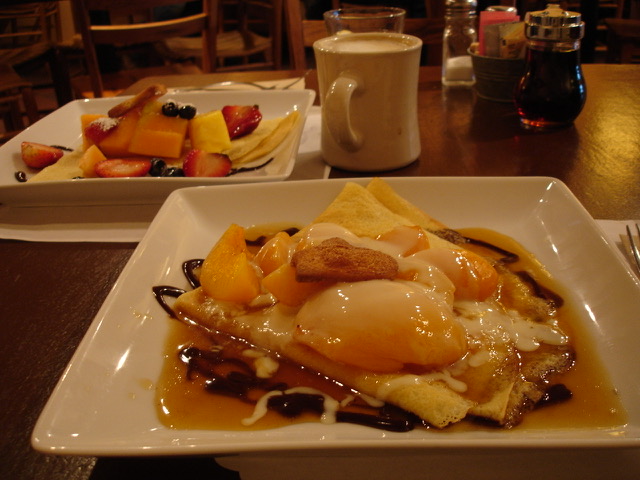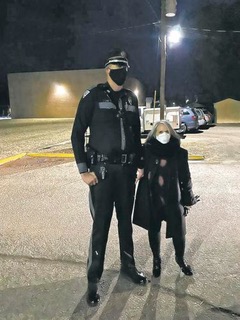“A foodie is a person who has an ardent or refined interest in food, and who eats food not only out of hunger but also as a hobby.” Wikipedia.com
We are not really “foodies.” It is true that back in CT we were members of a Gourmet Group for many years. And enjoyed lots of good food at each other’s homes and at local restaurants. But this crowd was as much about the camaraderie as about the cuisine. And for us it still is that way. One thing we really missed during the Covid lockdown out here was having meals with friends at restaurants. We held al fresco, BYO take-out get togethers at ours and other houses – and that took care of the “with friends” part of the experience. But we also wanted the atmosphere of the eatery. Poring over the menu and not limiting our choices to items that “travel well.” Background aromas that lingered on our clothing into the next day. Mouth-watering entrees being whisked past our table to those of other diners – many of which we only enjoy vicariously anyway, because they are just too damn spicy for our unpracticed New England taste buds. But it doesn’t hurt to look, does it?
“Real” New Mexicans are a blend of Native American, Spanish and Anglo. As a result “New Mexico cuisine is a blend of Native American, Spanish and Anglo tastes. While it shares some traits with Mexican and Tex-Mex cuisine, it is distinctive. Chile (note the spelling) is the main ingredient that makes New Mexico food stand out ... New Mexico Pueblo tribes have been cultivating chile, [and the “three sisters”] corn, beans and squash for millennia.” When New Mexicans refer to chile they are talking about a red or green sauce made from those pods, not chili con carne. In the 1500s the Spanish introduced wheat, rice, beef, lamb and other foods and flavors. “Staples on New Mexico menus include beef and chicken enchiladas, tamales, carne adovada (red chile-marinated pork), burritos, huevos rancheros and chiles rellenos (green chiles stuffed with cheese then deep fried) … Calabacitas [which we do eat and enjoy] is a side dish of corn, squash, chile and beans ... An Anglo influence is New Mexico's beloved green-chile cheeseburger and Frito pie (red chile poured over a bag of Fritos).” (travelchannel.com) Notice how many times “chile” appeared in that one paragraph.
“Red or green (Chile)?” is the “Official State Question.” To which an acceptable answer is “Christmas” meaning both. And the operative word out here is “smothered” with just about everything buried under an avalanche of the spicy sauce – including the first meal of the day.
Just fine with our breakfast buddies L & P – also morning people so 8:00 a.m. gatherings around a social meal are just their cup of tea (so to speak.) We take turns picking the eatery, with the other’s concurrence. Recently we tried Tia Sophia’s in downtown Santa Fe – believed to be the first restaurant on earth to put the breakfast burrito on its menu. “Soft tortillas are stuffed with bacon and hash browns, smothered in melted cheese and served with a poached egg on top” – and buried under red and/or green chile. The dish made the Food Network 2015 list of best breakfast meals across the nation.
But we did not know all that history until after. Which might have changed our orders – or at least L’s and P’s who selected Huevos Rancheros instead, also smothered. We however went for blue corn pancakes (M) and blueberry pancakes (J) smothered in our “spice of choice” – real maple syrup. We know that we could always ask for the chile “on the side” and spatter it on in harmless helpings. That is, after all, what we advise newcomers to do. But that compromises the entire essence of the entree – its whole raison d'être. And that seems wrong to us. Better to admire it from a safe distance.
During Covid we looked for places with outdoor seating. This brought us back to Cafe Fina – “an old Fina gas station turned eatery” – where first we began our morning get togethers in 2019. The menu features the requisite breakfast burrito, a smothered “huevos” dish (in this case “Huevos Motulenos, over easy organic eggs on a corn tortilla with black beans, feta cheese, peas, sautéed bananas and red or green chile”) – plus lots of things for us heat-averse Anglos including “Migas, scrambled organic eggs with corn tortillas sautéed with mild salsa and NM asadero cheese. served with black beans, sour cream, guacamole and a whole wheat tortilla.” Note particularly the presence of the word “mild” and the absence of “smothered.”
But not all Santa Fe breakfast bistros had pre-Covid open air seating. Some, like Claflutis a “low-key, French country-style spot for house-made baked goods & light breakfast/brunch/lunch fare,” created a pop up outdoor area in their parking lot under a white tent.
The two of us discovered Claflutis back in 2005 when Monica and Bram moved to Santa Fe and we began spending Christmas here with them. We rented a casita in the Guadalupe District – west of downtown and, serendipitously, just down the street from the restaurant. (It has since moved to the South Capitol area.) We dined there several times per trip and always on December 24th when we picked up an assortment of French baked goods to bring to M & B’s on Christmas morning. At Claflutis the “c word” was not “chile” but “croissant” or “crepe.” The latter buried under a pile of fresh fruits or glazed peaches. As was the French toast. Both with syrup made from the sap of non-local maple trees.
Another stop on the L&P&M&J breakfast tour was Cafecito, a “laid-back restaurant & coffee shop crafting Armenian, Argentinian & Italian dishes in an airy space.” We visited it during what passes for a “snow event” out here, but was just another drive in the country to us blizzard-hardened former New Englanders. The objects of our quest were empanadas – among them this Argentinian spin on NM’s mandatory morning meal, the “Breakfast Empanada filled with egg, hash browns, bacon, chorizo sausage, provolone. Served with chimichurri, green chile sauce and mixed greens.” The owner/waitress told us proudly that their chile was mild. And it was in fact quite tame. She also boasted that they never “smothered” anything with anything there.
There have been, and will be, many more breakfast outings. But writing about them is just making us hungry. Perhaps when you visit we can share some of them with you. Until then we will wrap it up with this brief story.
Tia Sophia’s describes itself as a “no-frills, diner-style eatery.” A crowded layout with rows of small wooden booths, narrow aisles, a couple of tables and a food bar. We ate there on the Sunday before election day. As we were leaving, walking single file, we passed the booth next to ours which sat kitty-corner to our route. And saw the incumbent Governor of New Mexico, Michelle Lujan Grisham, having a casual breakfast with two other women. She looked at us and smiled warmly. We reciprocated and when we caught up at the exit asked L & P, “was that the Guv?” They assured us it was. And L went back to say something supportive to her. (BTW It is not that easy to spot MLG in a crowd. At 5’1” she is the nation’s shortest, highest elected state executive. The attached shows her next to a 7’ tall NM State Trooper.)
Her Republican opponent was, like us, a former New Englander (Vermont) – and assumedly raised with a northeastern food palate. We don’t know his position on maple syrup vis-à-vis other “spices” – or what he had for breakfast that day. But Grisham, a 12th generation New Mexican, was feasting on something that was so smothered in red and green sauce as to be unidentifiable.
She won the election 52% to 46%.
Did the morning meal choices of the candidates help determine the winner? Probably not. But we will never know for sure, will we?
Either way, it should be clear to even someone without “an ardent or refined interest in food” (such as us) that chile, and lots of it, is the main ingredient of a “breakfast of champions” out here.




















